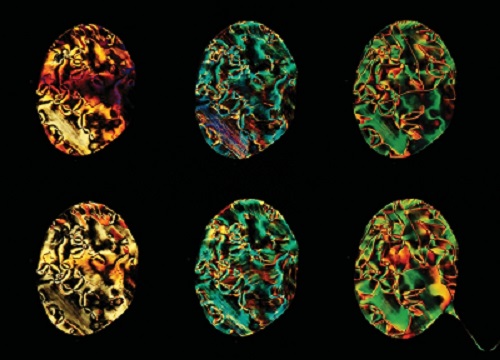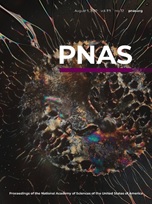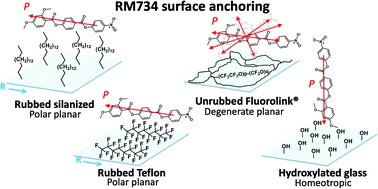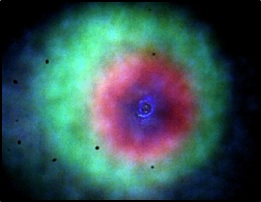
Fluid jets and polar domains, on the relationship between electromechanical instability and topology in ferroelectric nematic liquid crystal droplets.
Ferroelectric nematic liquid crystals are a class of recently discovered fluid materials formed by highly polar molecules that spontaneously align along a common direction, giving rise to a macroscopic polarization P. Since the polarization vector is locally collinear to the optical axis n, the study of the spatial patterns of n enables deducing the structure of P. We have carried on such topological study on
ferroelectric nematic droplets confined between two solid ferroelectric substrates both when the droplet is in equilibrium and during a jet-emission phase that takes place when the solid surfaces become sufficiently charged. We find that in equilibrium the droplet splits in striped domains in which P has alternating directions.
Soft Matter, 2024, 20, 4878

A new twist in ferroelectric liquids
Spontaneous chirality emerges in a highly polar liquid of achiral molecules
By Liana Lucchetti
Liquid crystals are of scientific interest because of their many potential applications in soft matter–based technologies. The most studied liquid crystal phase is the nematic (N), in which molecules possess orientational but not positional order. The recent discovery of the ferroelectric nematic (NF) phase, the polar variant of the N phase, demonstrated that liquid systems can have spontaneous polarization comparable to that of ferroelectric solid crystals. On page 1096 of this issue, Karcz et al. (1) report a ferroelectric nematic liquid crystal composed of achiral molecules in which strong dipolar interactions drive the spontaneous formation of a chiral phase. This demonstrates that chirality can emerge in achiral systems as a result of electrostatic interactions and that NF systems can exhibit spontaneous twist of molecular dipoles that minimizes electrostatic energy. Kumari et al. (2) also recently showed that, under proper conditions, the energetically favored ground state configuration of NF liquid crystals is chiral.

Fluid superscreening and polarization following in confined ferroelectric nematics.
The recently discovered ferroelectric nematic (NF) liquid-crystal phase exhibits a spontaneous polarization field that is both orientationally fluid like a liquid crystal and large in magnitude like a solid ferroelectric. This combination imparts this phase with a unique electrostatic phenomenology and response to applied fields. Here we probe this phase by applying a small electric field to ferroelectric nematics confined in microchannels that connect electrodes through straight and curved paths and find that the NF phase smoothly orders with its polarization following the channels despite their winding paths. This implies a corresponding behaviour of the electric field. On inversion of the electric field, the polar order undergoes a multistage switching process dominated by electrostatic interactions. We also find multistage polarization switching dynamics in the numerical simulations of a quasi-two-dimensional continuum model of channel-confined NF liquid crystals, enabling the exploration of their internal structural and electrical self-organization. This indicates that polarization alignment and electric-field guiding are direct consequences of fluid superscreening—the prompt elimination of electric-field components normal to the channel walls by polarization reorientation. This response mimics the behaviour expected for ultrahigh-permittivity dielectrics, but with patterns of charge accumulation and local ordering unique to fluid ferroelectrics.
Nature Physics, 19, 1658–1666 (2023). https://doi.org/10.1038/s41567-023-02150-z

Explosive electrostatic instability of ferroelectric liquid droplets on ferroelectric solid surfaces.
In this work, we show that when sessile droplets of the newly discovered ferroelectric nematic fluid phase are deposited on a ferroelectric solid substrate, they can become suddenly unstable and disintegrate though the emission of fluid jets. The instability is due to the coupling between the polarizations of the liquid and solid materials, which induces the accumulation of polarization charges on the droplet–air interface and thus, the buildup of a repulsion pressure that eventually overcomes the surface tension. This kind of polarization-induced Rayleigh instability crucially depends on the unique combination of polarization and fluidity of the ferroelectric nematic and might provide the basis for electrohydromechanical applications.
PNAS, 119 (32) e2207858119 2022 https://doi.org/10.1073/pnas.2207858119

Surface alignment of ferroelectric nematic liquid crystals
The coupling of the newly discovered ferroelectric liquid crystal with solid surface gives rise to a variety of orientation, defects and electric field response that are a consequence of the polar symmetry breaking and depend on the specific surface.
Soft Matter, 2021,17, 8130-8139 https://doi.org/10.1039/D1SM00734C

Pitch tuning induced by optical torque in heliconical cholesteric liquid crystals
Heliconical cholesteric liquid crystals are expected to be more sensitive to torque induced by light field since their structure allows both bend and twist in molecular orientations, differently from the conventional cholesterics in which only twist deformation is involved, requiring much higher fields. We report here a demonstration of tuning the helical pitch in heliconical cholesterics induced by an optical torque. Experimental observations are in agreement with expectations of the classical theory extended to include the effect of the optical field. A dual control of the helical pitch is achieved including both the low-frequency electric field applied along the helix axis and the optical field orthogonal to it.
Phys. Rev. Research 1, 033215 (2019)

Walking Ferroelectric Liquid Droplets with Light
The motion of ferroelectric liquid sessile droplets deposited on a ferroelectric lithium niobate substrate can be controlled by a light beam of moderate intensity irradiating the substrate at a distance of several droplet diameters from the droplet itself. The ferroelectric liquid is a nematic liquid crystal, in which almost complete polar ordering of the molecular dipoles generates an internal macroscopic polarization locally collinear to the mean molecular long axis. Upon entering the ferroelectric phase, droplets are either attracted toward the center of the beam or repelled, depending on the side of the lithium niobate exposed to light irradiation. Moreover, moving the beam results in walking the ferroelectric droplet over long distances on the substrate. This behavior is understood as due to the coupling between the polarization of the ferroelectric droplet and the polarization photoinduced in the irradiated region of the lithium niobate substrate. Indeed, the effect is not observed in the conventional nematic phase, suggesting the crucial role of the ferroelectric liquid crystal polarization.
Adv.Mater.2023, 35, 2212067

Elasticity and Viscosity of DNA Liquid Crystals
Concentrated solutions of blunt-ended DNA oligomer duplexes self-assemble in living polymers and order into lyotropic nematic liquid crystal phase. Using the optical torque provided by three distinct illumination geometries, we induce independent splay, twist, and bend deformations of the DNA nematic and measure the corresponding elastic coefficients K1, K2, and K3, and viscosities ηsplay, ηtwist, and ηbend. We find the viscoelasticity of the system to be remarkably soft, as the viscoelastic coefficients are smaller than in other lyotropic liquid crystals. We find K1 > K3 > K2, in agreement with the elasticity of the nematic phase of flexible polymers, and ηbend > ηsplay > ηtwist a behavior that is nonconventional in the context of chromonic, polymeric, and thermotropic liquid crystals, indicating a possible role of the weakness and reversibility of the DNA aggregates.
ACS Macro Lett. 2020, 9, 1034−1039

Optofluidic platform using liquid crystals in lithium niobite microchannel
SCIENTIFIC REPORTS vol.9, 1062 (2019)